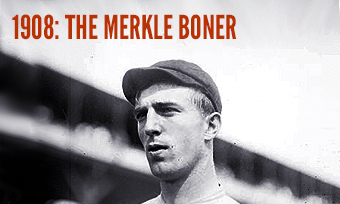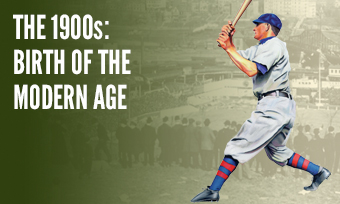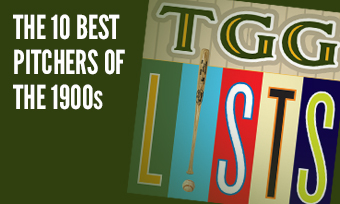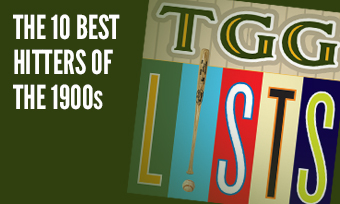The Yearly Reader
Leaders and Honors, 1908
Our list of baseball’s top 10 hitters and pitchers in both the American League and National League for the 1908 baseball season, as well as the awards and honors given to the game’s top achievers of the year.
The National League’s Top 10 Hitters, 1908
Bold type in brick red indicates league leader.
1. Honus Wagner, Pittsburgh
Key Numbers: .354 average, 100 runs, 201 hits, 39 doubles, 19 triples, 10 home runs, 109 RBIs, 53 stolen bases.
In a dominant decade, Wagner was quite possibly at his most dominant—and reached double figures in home runs for only the second (and last) time of his storied career.
2. Mike Donlin, New York
Key Numbers: .334 average, 198 hits, 13 triples, 6 home runs, 106 RBIs.
Continuing to flip-flop between acting and baseball, Donlin gave it one last impressive go-around on the field before returning to the stage.
3. Hans Lobert, Cincinnati
Key Numbers: .293 average, 18 triples, 4 home runs, 63 RBIs, 47 stolen bases.
No other player on the Reds hit higher than .250.
4. Sherry Magee, Philadelphia
Key Numbers: .283 average, 30 doubles, 16 triples, 40 stolen bases.
One of Magee’s quieter years amid a stellar career, but everything was relative at the height of the Deadball Era.
5. Red Murray, St. Louis
Key Numbers: .282 average, 15 triples, seven home runs, 48 stolen bases.
The soon-to-be Giant was the Cardinals’ best hitter—but their worst outfielder (28 errors).
6. Johnny Evers, Chicago
Key Numbers: .300 average, 83 runs, 66 walks, 36 stolen bases.
A rare .300 turn for the guy better known defensively as the middle of the legendary Tinker-to-Evers-to-Chance double play combo.
7. Roger Bresnahan, New York
Key Numbers: .283 average, 25 doubles, 1 home run, 54 RBIs, 83 walks.
Soon to be traded to the Cardinals (for Red Murray) to become their manager, Bresnahan eclipsed .400 in on-base percentage for the fourth time in six years.
8. John Titus, Philadelphia
Key Numbers: .286 average, 75 runs, 2 home runs, 48 RBIs, 14 hit-by-pitches.
“Silent John” Titus quietly continued to play Magee’s equal in the Phillies’ batting order—and he continued to stick out of a crowd with a 1890s-style handlebar mustache that had grown passé by 1908.
9. Fred Clarke, Pittsburgh
Key Numbers: .265 average, 83 runs, 15 triples, 2 home runs, 53 RBIs, 65 walks.
The player-manager’s average was one of the lowest of his career, but as we mentioned above about Magee, few hitters thrived in a season dominated by incredible pitching.
10. Frank Chance, Chicago
Key Numbers: 129 games, .272 average, 27 doubles, 2 home runs, 55 RBIs, 27 stolen bases.
The Peerless Leader logged 100 games for the last time in his career while guiding the Cubs to their last world championship until 2016.
The American League’s Top 10 Hitters, 1908
1. Ty Cobb, Detroit
Key Numbers: .324 average, 88 runs, 188 hits, 36 doubles, 20 triples, 4 home runs, 108 RBIs, 39 stolen bases.
Though his average would be his lowest until his final season 20 full years later, it was still good enough to earn him his second of many, many batting titles.
2. Sam Crawford, Detroit
Key Numbers: .311 average, 102 runs, 184 hits, 33 doubles, 16 triples, 7 home runs, 80 RBIs.
Crawford became the first player to win home run titles in both the NL and AL—even if the seven he hit represented the lowest ever collected by an AL season leader.
3. Matty McIntyre, Detroit
Key Numbers: .295 average, 105 runs, 13 triples, 83 walks.
The Tigers’ leadoff man, after missing almost all of 1907 to a broken ankle, greatly benefitted from the presence of Cobb and Crawford in the lineup behind him.
4. Doc Gessler, Boston
Key Numbers: 128 games, .308 average, 14 triples, 3 home runs, 63 RBIs.
A poor defensive outfielder, Gessler at least provided enough sock in the Red Sox’ offense to justify his everyday presence in the lineup.
5. Nap Lajoie, Cleveland
Key Numbers: 157 games, .289 average, 32 doubles, 74 RBIs.
In the midst of a relative mid-life crisis at the plate, Lajoie still put up good numbers—but missed on his best chance to reach the World Series.
6. Charlie Hemphill, New York
Key Numbers: .297 average, 59 walks, 42 stolen bases.
The veteran center fielder had a strong first year with the Highlanders after spending the previous seven seasons with three other AL teams; it unfortunately would be his lone season of success as decline soon set in.
7. Patsy Dougherty, Chicago
Key Numbers: .278 average, 47 stolen bases.
The most hit-worthy among the 1908 edition of Chicago’s Hitless Wonders, Dougherty’s 47 steals represented the most of his career, while his average was easily the team’s best. (Most everyone else hit closer to an even .200.)
8. George Stone, St. Louis
Key Numbers: .281 average, 89 walks, 8 triples, 5 home runs, 31 RBIs, 20 stolen bases.
Stone’s batting average dropped 40 points for the second straight year, but he still remained among the AL’s tougher outs.
9. Germany Schaefer, Detroit
Key Numbers: .259 average, 96 runs, 10 triples, 3 home runs, 52 RBIs, 43 sacrifice hits, 40 stolen bases.
Best remembered for “stealing” first base—running from second back to first to distract pitchers from other runners on base—Schaefer, like Matty McIntrye (above), felt a statistical surge from batting in front of Cobb and Crawford in the Detroit lineup.
10. Jake Stahl, New York-Boston
Key Numbers: .250 average, 27 doubles, 16 triples, 2 home runs, 65 RBIs, 23 hit-by-pitches.
Hit an AL-high 23 times by pitches, Stahl seemed to be liked by few opponents—especially his former teammates in New York, who plunked him three times in seven games after his trade to the Red Sox.
The National League’s Top 10 Pitchers, 1908
1. Christy Mathewson, New York
Key Numbers: 1.43 ERA, 37 wins, 11 losses, 56 appearances, 44 starts, 11 shutouts, 390.2 innings, 42 walks.
Though Big Six had more efficient campaigns, none were more over-encompassing than 1908, setting career highs in wins, innings and appearances. But he would have traded most of that to win that final game against the Cubs.
2. Three Finger Brown, Chicago
Key Numbers: 1.47 ERA, 29 wins, 9 losses, 312.1 innings.
Unlike Mathewson, Brown didn’t need to trade anything away—he won that final game against the Giants’ ace and finished 4-0 against him on the year.
3. George McQuillan, Philadelphia
Key Numbers: 1.53 ERA, 23 wins, 17 losses, 48 appearances, 42 starts, 359.2 innings.
McQuillan looked destined for greatness as he followed up a wowing late-season stint in 1907, but 1908 would be as good as it got.
4. Vic Willis, Pittsburgh
Key Numbers: 2.07 ERA, 23 wins, 11 losses, 7 shutouts, 304.2 innings.
Another season, another 20 wins for the Pirates’ ace as he continued to make up for lost victories from his earlier days with the destitute Boston Beaneaters.
5. Kaiser Wilhelm, Brooklyn
Key Numbers: 1.87 ERA, 16 wins, 22 losses, 33 complete games, 332 innings.
Wilhelm returned to the majors a much better pitcher after two years away—but still couldn’t shake the stigma of being a 20-game loser; he tied Harry Howell’s 1905 mark for the moss losses by a pitcher with a sub-2.00 ERA.
6. Hooks Wiltse, New York
Key Numbers: 2.24 ERA, 23 wins, 14 losses, 44 appearances, 38 starts, 330 innings.
With an exhausted Joe McGinnity beginning the burnout phase of his career, Wiltse took over as Mathewson’s new complement in the Giants’ rotation.
7. Bugs Raymond, St. Louis
Key Numbers: 2.03 ERA, 15 wins, 25 losses, 48 appearances, 37 starts, 324.1 innings.
The talented spitballer fought two battles: The bottle (which would ultimately overcome him) and the Cardinals, who were shut out in 11 of his 25 losses.
8. Howie Camnitz, Pittsburgh
Key Numbers: 1.56 ERA, 16 wins, 9 losses.
Though Vic Willis and Nick Maddox were the Pirates’ top winners with 23 each, Camnitz easily had them both beat on ERA.
9. Ed Reulbach, Chicago
Key Numbers: 2.03 ERA, 24 wins, 7 losses, .774 win percentage, 297.2 innings.
Reulbach’s year included a streak of 44 consecutive scoreless innings, which would hold as the NL record for the next 25 years.
10. Lew Richie, Philadelphia
Key Numbers: 1.83 ERA, 7 wins, 10 losses.
Yet another epitome of the Deadball Era’s peak, as Richie took the good (1.83 ERA) with the bad (losing record, a pitiful 2.13 runs of support per start).
The American League’s Top 10 Pitchers, 1908
1. Addie Joss, Cleveland
Key Numbers: 1.16 ERA, 24 wins, 11 losses, 325 innings, 30 walks.
In his last great season—and his last of four straight years winning at least 20—Joss established the AL’s third-lowest season ERA.
2. Ed Walsh, Chicago
Key Numbers: 1.42 ERA, 40 wins, 15 losses, .727 win percentage, 66 appearances, 49 starts, 464 innings.
Chicago sportswriter Charlie Dryden said that Walsh was “the only man who can strut standing still.” And the White Sox’ über-workhorse never strutted more than in 1908.
3. Cy Young, Boston
Key Numbers: 1.26 ERA, 21 wins, 11 losses, 299 innings.
What’s most remarkable about Young’s 1.26 ERA—the fourth best in AL history, right behind Addie Joss—is that he accomplished it at age 41. Also: His .213 batting average allowed was his lowest in 16 years.
4. Frank Smith, Chicago
Key Numbers: 2.03 ERA, 16 wins, 17 losses, 297.2 innings.
You gotta wonder if the hard-luck spitballer was asking teammate Ed Walsh (above) to gift some of his 40 wins toward him. Smith would have had more W’s had he not split from the team for six weeks in midsummer after being fed up with criticism of his control from White Sox owner Charles Comiskey.
5. Ed Summers, Detroit
Key Numbers: 1.64 ERA, 24 wins, 12 losses, 301 innings.
The rookie knuckleballer was easily the best of four different pitchers on the Tigers named Ed.
6. Bill Burns, Washington
Key Numbers: 1.70 ERA, 6 wins, 11 losses.
If being pinned with a lousy record despite a fine ERA—something that would dog him throughout his career—wasn’t enough, then maybe it was losing out on a no-hitter with two outs in the ninth, the first of two such starts he would endure. No wonder Burns later turned to gambling and a role in the Black Sox Scandal.
7. Walter Johnson, Washington
Key Numbers: 1.65 ERA, 14 wins, 14 losses.
The Big Train, making his debut on this list, was luckier than Burns in one regard; he avoided a losing record for the sad-sack Senators.
8. Harry Howell, St. Louis
Key Numbers: 1.89 ERA, 18 wins, 18 losses, 324.1 innings.
A year before his arm blew out to essentially end his career, Howell capped a five-year run not so much remarkable for his ERA during this stretch (2.02) but a below-.500 (77-90) record for a Browns team that, with one exception (1905), really wasn’t that bad.
9. Rube Waddell, St. Louis
Key Numbers: 1.89 ERA, 19 wins, 14 losses, 285.2 innings.
The eccentric Waddell helped give the Browns rare prominence in the standings—it would be their last winning season for eight years—after his tiresome Philadelphia A’s teammates lobbied to get him traded.
10. Rube Vickers, Philadelphia
Key Numbers: 2.21 ERA, 18 wins, 19 losses, 53 appearances, 317 innings.
The A’s replaced one Rube with another in one-shot wonder Rube Vickers, who would lack Waddell’s irksome panache—but also his career stamina.









